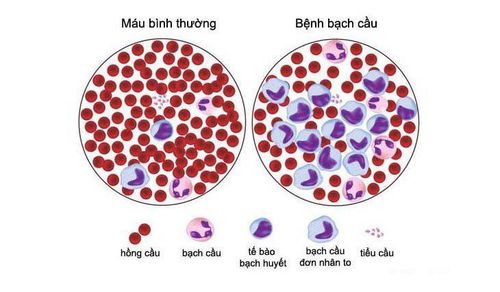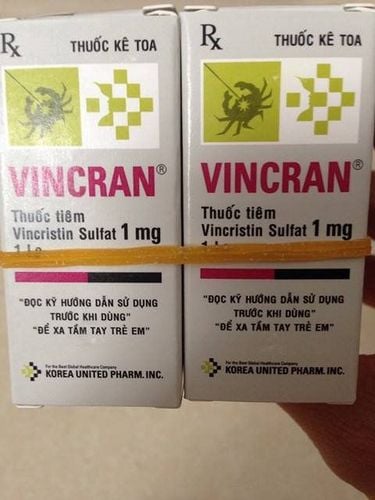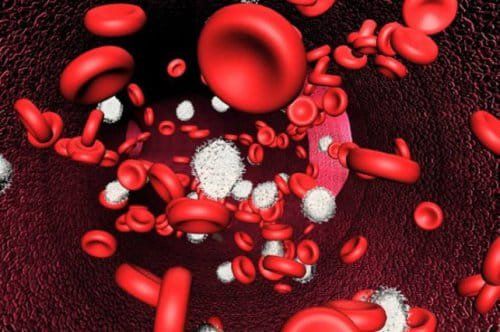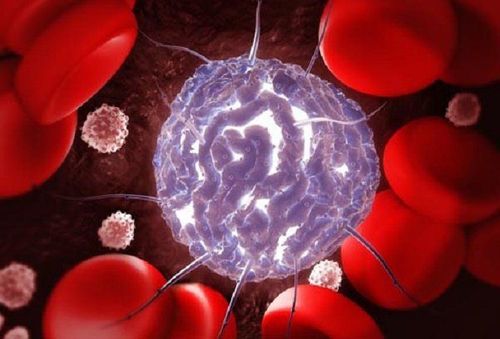This is an automatically translated article.
Chronic Lymphocytic Leukemia (CLL) is a slow-growing blood cancer that affects lymphocytes, a type of white blood cell.
1. What is chronic lymphocytic leukemia?
Chronic leukemia is a malignancy of the blood system and bone marrow, where blood is produced in the adult body. The term “chronic” implies a slower progression of the disease compared to other forms of leukaemia. In chronic lymphocytic leukemia, the affected cell line is lymphocytes, which play a role in protecting the body against bacterial infections.
Tế bào máu khi mắc bệnh bạch cầu mãn tính dòng lympho
2. Risk factors for chronic lymphocytic leukemia
Risk factors for chronic lymphocytic leukemia are subjective and objective factors that increase the likelihood of developing the disease, related to occupation, environmental exposure, lifestyle, family history, and medical history. personal medical history. The risk factors are not the direct cause of the disease but do contribute to accelerating the progression of chronic leukemia. Some people carry multiple risk factors but never develop the disease in their lifetime, while those with no risk factors develop the disease. Knowing your own risk factors to discuss with your doctor will give you more options to change your lifestyle and take care of your health in a more beneficial direction. The cause of chronic lymphocytic leukemia is currently unknown. Exposure to radiation and chemicals has not been shown to increase the risk of chronic leukemia. However, some of the following factors may increase your risk, including:
Family history: Having more than 1 family member with chronic lymphocytic leukemia or other malignancies Other white blood cell-related properties are risk factors that increase the likelihood of disease. The risk is increased 2 to 4 times if the affected relatives are in the first generation, including parents, siblings and children. This is an uncommon clinical feature and cannot be changed.
Age: Clinically, chronic lymphocytic leukemia is common in elderly patients, rarely in young people, and very rarely in children. 90% of patients with chronic lymphocytic leukemia are over 50 years of age. The average age of those infected is 71 years old.

90% bệnh nhân mắc bệnh bạch cầu mãn tính dòng lympho thuộc nhóm đối tượng trên 50 tuổi
Gender: Many statistics are done and it is found that men have a higher rate of chronic lymphocytic leukemia than women.
Race: Chronic B-cell leukemia is common in Russia and European countries, rarely seen in China, Japan, and Southeast Asian countries. The disease is also common in black people. The reason for this difference is not well explained.
Agent Orange: According to the United States Department of Veterans Affairs, chronic lymphocytic leukemia is strongly associated with exposure to Agent Orange. This is a poison used during the Vietnam War, causing many devastating consequences, lasting for generations of the Vietnamese people. In addition to Agent Orange, a number of other chemicals such as pesticides, chemical fertilizers and cleaning agents have also been linked to an increased incidence of chronic leukemia.
Monoclonal B-lymphocyte hyperplasia: This is a condition in which the monoclonal B-lymphocyte count is above normal but has not yet reached the threshold to be classified as chronic lymphocytic leukemia. It is thought that a small percentage of people with monoclonal B-cell hyperplasia develop chronic lymphocytic leukemia.
Many studies have been done to find out the risk factors for chronic lymphocytic leukemia. In addition to the factors mentioned above, smoking, pneumonia, occupational exposure to petroleum, metals are also associated with chronic lymphocytic leukemia.
In general, the risk factors for chronic lymphocytic leukemia are non-modifiable factors, including family history, age, gender, and race. The remaining minority is a group of uncommon factors. Although chronic leukemia is a malignant disease, there are now treatments to help control the course of the disease. Therefore, recognizing the risk factors and informing the doctor plays a very useful role in early detection if the disease is unfortunate and increasing the effectiveness of treatment when the disease is not severe.
Early cancer screening is considered the "golden key" for early detection and effective cancer prevention and treatment regimens, thereby reducing the risk of death and reducing costs for people. sick. Currently, Vinmec International General Hospital has been a leading medical facility in the field of cancer detection and screening even when there are no symptoms. The high-tech cancer screening package at Vinmec gives you the opportunity to screen and detect disease warning risks in time to optimize treatment efficiency and improve quality of life.
Please dial HOTLINE for more information or register for an appointment HERE. Download MyVinmec app to make appointments faster and to manage your bookings easily.













